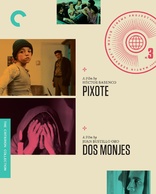
◎译 名 街童 / 街童日記(港)
◎片 名 Pixote: A Lei do Mais Fraco
◎年 代 1981
◎产 地 巴西
◎类 别 剧情 / 犯罪
◎语 言 葡萄牙语
◎上映日期 1981-09-11
◎片 长 128 分钟
◎导 演 海科特·巴班克 Hector Babenco
◎编 剧 海科特·巴班克 Hector Babenco / José Louzeiro / Jorge Durán
◎主 演 扎德尔·弗赫 Jardel Filho
Jorge Julião
Gilberto Moura
Edilson Lino
Zenildo Oliveira Santos
Claudio Bernardo
Israel Feres David
Jose Nilson Martin Dos Santos
鲁本斯·法尔科 Rubens de Falco
Beatriz Berg
Walter Breda
Lineu Dias
Isadora de Farias
Elke Maravilha
Ariclê Perez
马里利娅·佩拉 Marília Pêra
Fernando Ramos da Silva
Beatriz Segall
托尼·托尔纳多 Tony Tornado
Luiz Serra
◎标 签 巴西 | 犯罪 | 巴西电影 | 儿童 | 1981 | 青春 | 拉美 | Hector.Babenco
◎简 介
《街童》是阿根廷著名导演赫克托.巴本科第一部获得国际声誉的经典影片,是80年代巴西最好的电影之一,1982年金球奖最佳外语片提名等众多国际性电影大奖。
◎译 名 两个僧侣/Two Monks
◎片 名 Dos Monjes
◎年 代 1934
◎产 地 墨西哥
◎类 别 剧情/爱情/悬疑/奇幻
◎语 言 西班牙语
◎上映日期 1934-11-28
◎片 长 Mexico: 85 分钟
◎导 演 胡安·布斯蒂略·奥罗 Juan Bustillo Oro
◎编 剧 胡安·布斯蒂略·奥罗 Juan Bustillo Oro
◎主 演 Víctor Urruchúa
Carlos Villatoro
Emma Roldán
曼努埃尔·安东尼奥·诺列加 Manuel Noriega
Manuel Noriega
◎标 签 墨西哥 | 1930s | 超现实 | 表现主义 | 超现实主义 | 诡异 | 墨西哥电影 | 哥特
◎简 介
Masterpiece precedes 'Rashomon'.
One of the greatest films of all time is Kurosawa's 'Rashomon', which features an unusual narrative structure: the same events are shown in flashback four times, each time from the viewpoint of a different character. The subtle differences in each flashback compel the viewers to decide for themselves the truth of what actually happened. 'Rashomon' (1950) proved to be so innovative that several later films have used the same idea. I can think of at least three different sitcoms, each of which has done an episode ripping off the 'Rashomon' premise.
The 1934 Mexican film 'Two Monks' uses precisely this same narrative gimmick, 16 years before it was used in 'Rashomon'. Unfortunately, because 'Two Monks' uses only two conflicting flashbacks (rather than four, as in 'Rashomon&apos:wink:, the audience are put in an "either/or" situation rather than a pick'n'mix. Still, it's intriguing to see that one of the most famous narrative innovations in the entire history of film was used in an obscure Mexican movie more than a decade before it was employed in the film that brought it to greatness and prominence.
Juan and Javier are two young men, rivals for the charms of pretty Anita. She dies, in circumstances which are intentionally kept obscure, and the rivals go their separate ways. Javier becomes a monk, and puts his painful memories behind him ... until, one day in the priory, he encounters a monk who turns out to be Juan. Straight away, Javier is so angered that he attacks Juan, giving him a near-fatal blow.
The kindly old prior confesses each of the two men separately. Each confession is shown in flashback, with first one man and then the other telling the story of the tragic triangle from his own self-serving viewpoint. Now we learn -- from two conflicting viewpoints -- what happened to Anita.
The art direction throughout this film is astonishing, and there is the clever touch of having each of the rivals dressed in white in his own flashback, but garbed in black in the other man's flashback: a splendid way of helping the audience to remember that this narrative is subjective.
'Two Monks' deserves to be much, much better known, and I eagerly rate this film 10 out of 10.
 淘宝店铺:http://94hd.taobao.com
淘宝店铺:http://94hd.taobao.com